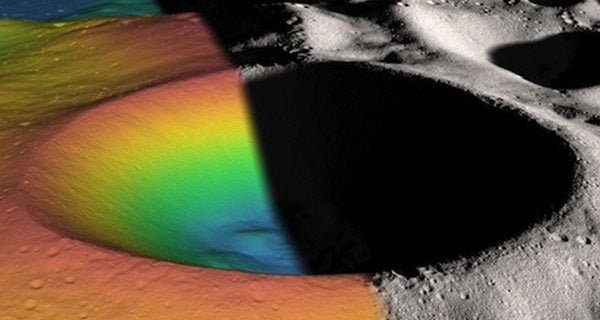A team of NASA and university scientists using laser light from LRO’s laser altimeter examined the floor of Shackleton Crater. They found that the crater’s floor is brighter than those of other nearby craters, which is consistent with the presence of small amounts of ice. This information will help researchers understand crater formation and study other uncharted areas of the Moon.
“The brightness measurements have been puzzling us since two summers ago,” said Gregory Neumann of NASA’s Goddard Space Flight Center in Greenbelt, Maryland. “While the distribution of brightness was not exactly what we had expected, practically every measurement related to ice and other volatile compounds on the Moon is surprising, given the cosmically cold temperatures inside its polar craters.”
The spacecraft mapped Shackleton Crater with unprecedented detail, using a laser to illuminate the crater’s interior and measure its albedo, or natural reflectance. The laser light measures to a depth comparable to its wavelength, or about a micron. That represents a millionth of a meter, or less than one ten-thousandth of an inch. The team also used the instrument to map the relief of the crater’s terrain based on the time it took for laser light to bounce back from the Moon’s surface. The longer it took, the lower the terrain’s elevation.
In addition to the possible evidence of ice, the group’s map of Shackleton revealed a remarkably preserved crater that has remained relatively unscathed since its formation more than 3 billion years ago. The crater’s floor is itself pocked with several small craters, which may have formed as part of the collision that created Shackleton.
The crater, named after the Antarctic explorer Ernest Shackleton, is 2 miles (3 kilometers) deep and more than 12 miles (19 kilometers) wide. Like several craters at the Moon’s south pole, the small tilt of the lunar spin axis means Shackleton Crater’s interior is permanently dark, and therefore extremely cold.
“The crater’s interior is extremely rugged,” said Maria Zuber from the Massachusetts Institute of Technology in Cambridge. “It would not be easy to crawl around in there.”
While the crater’s floor was relatively bright, Zuber and her colleagues observed that its walls were even brighter. The finding was at first puzzling. Scientists had thought that if ice were anywhere in a crater, it would be on the floor where no direct sunlight penetrates. The upper walls of Shackleton Crater are occasionally illuminated, which could evaporate any ice that accumulates. A theory offered by the team to explain the puzzle is that “moonquakes”— seismic shaking brought on by meteorite impacts or gravitational tides from Earth — may have caused Shackleton’s walls to slough off older darker soil, revealing newer, brighter soil underneath. Zuber’s team’s ultra-high-resolution map provides strong evidence for ice on both the crater’s floor and walls.
“There may be multiple explanations for the observed brightness throughout the crater,” said Zuber. “For example, newer material may be exposed along its walls, while ice may be mixed in with its floor.”
This visualization, created using Lunar
Reconnaissance Orbiter laser altimeter data, offers a view of Shackleton
Crater located in the south pole of the Moon. Thanks to these
measurements, we now have our best-yet maps of the crater’s
permanently-shadowed interior! Note: This video contains no audio.
Credit: NASA/Goddard/Ernie Wright










